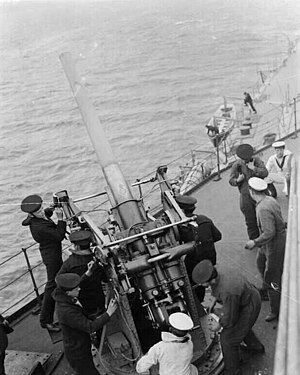QF 3 inch 20 cwt
| QF 3 inch 20 cwt anti-aircraft gun | |
|---|---|

Aboard HMS Royal Oak in World War I
|
|
| Type | Anti-aircraft gun |
| Place of origin | United Kingdom |
| Service history | |
| In service | 1914—46 |
| Used by |
United Kingdom Australia Canada Finland Ireland |
| Wars | World War I World War II |
| Production history | |
| Designer | Vickers |
| Specifications | |
| Weight | Gun & breech : 2,240 lb (1,020 kg) Total on 2 wheel platform : 5.99 tons |
| Barrel length | Bore: 11 ft 4 in (3.45 m) (45 cal) Total: 11 ft 9 in (3.58 m) |
| Crew | 11 |
|
|
|
| Shell | Fixed QF HE 1914: 12.5 lb (5.7 kg); 1916: 16 lb (7.3 kg) |
| Calibre | 3 inch (76.2 mm) |
| Breech | semi-automatic sliding block |
| Recoil | 11 inches. hydro spring, constant |
| Carriage | high-angle wheeled, static or lorry mounting |
| Elevation | -10° - 90° |
| Traverse | 360° |
| Rate of fire | 16-18 rpm |
| Muzzle velocity | 2,500 ft/s (760 m/s) (12.5 lb shell) 2,000 ft/s (610 m/s) (16 lb shell) |
| Effective firing range | 16,000 ft (4,900 m) |
| Maximum firing range | 23,500 ft (7,200 m) (12.5 lb shell) 22,000 ft (6,700 m) (16 lb shell) |
The QF 3 inch 20 cwt anti-aircraft gun became the standard anti-aircraft gun used in the home defence of the United Kingdom against German airships and bombers and on the Western Front in World War I. It was also common on British warships in World War I and submarines in World War II. 20 cwt referred to the weight of the barrel and breech, to differentiate it from other "3 inch" guns (1 cwt = 1 hundredweight = 112 lb, hence the barrel and breech together weighed 2250 lb). While other AA guns also had a bore of 3 inches, the term "3 inch" was only ever used to identify this gun in the World War I era, and hence this is what writers are usually referring to by "3 inch AA gun".
The gun was based on a prewar Vickers naval 3-inch (76 mm) QF gun with modifications specified by the War Office in 1914. These (Mk I) included the introduction of a vertical sliding breech-block to allow semi-automatic operation. When the gun recoiled and ran forward after firing, the motion also opened the breech, ejected the empty cartridge and held the breech open ready to reload, with the striker cocked. When the gunner loaded the next round, the block closed and the gun fired.
The early 12.5 lb (5.7 kg) shrapnel shell at 2,500 ft/s (760 m/s) caused excessive barrel wear and was unstable in flight. The 1916 16 lb shell at 2,000 ft/s (610 m/s) proved ballistically superior and was better suited to a high explosive filling.
The Mark I* had different rifling. The Mark II lost the semi-automatic action. The Mk III of 1916 reverted to a 2-motion screw breech to suit available manufacturing capability, and Mk IV had a single-tube barrel and single-motion screw breech; a Welin breech block with an Asbury breech.
A US Army report on anti-aircraft guns of April 1917 reported that this gun's semi-automatic loading system was discontinued because of difficulties of operation at higher angles of elevation, and replaced by "the standard Vickers-type straight-pull breech mechanism", reducing rate of fire from 22 to 20 rds/minute. Routledge quotes a rate of fire of 16-18 rounds per minute, in the context of the 16 pounder shell of 1916. This would appear to be the effective rate of fire found to be sustainable in action.
Beginning in 1930, a new towed 4-wheeled sprung trailer platform was introduced to replace the obsolete lorries still used as mounts from World War I, together with modern new barrels, and equipment to connect the guns to the new Vickers No. 1 Predictor. 8 more Mks followed between the World Wars. By 1934 the rocking-bar deflection sights had been replaced by Magslip receiver dials which received input from the Predictor, with the layers matching pointers instead of tracking the target. Predictor No. 1 was supplemented from 1937 by Predictor No. 2, based on a US Sperry AAA Computer M3A3. This was faster and could track targets at 400 mph (640 km/h) at heights of 25,000 ft (7,600 m), both Predictors received height data, generally from the Barr & Stroud UB 7 (9 feet base) instrument.
...
Wikipedia
